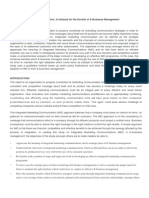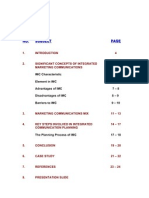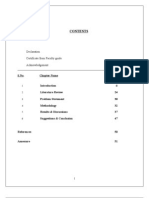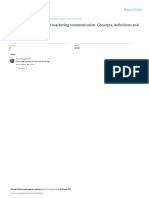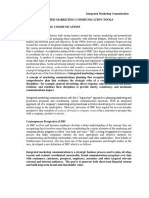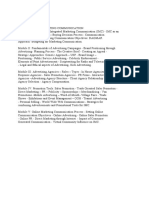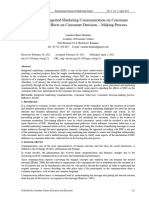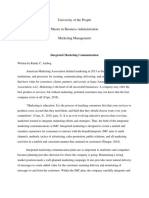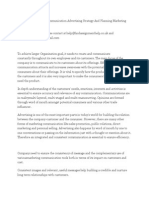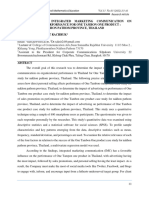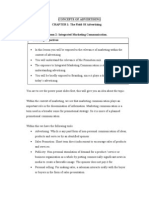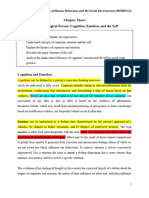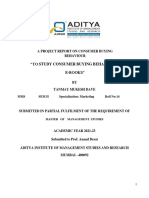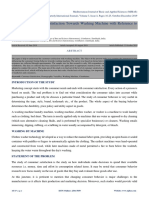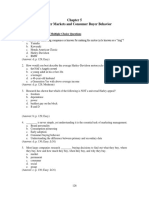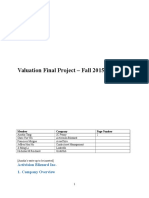ISSN 2348-1218 (print)
International Journal of Interdisciplinary Research and Innovations ISSN 2348-1226 (online)
Vol. 6, Issue 1, pp: (164-168), Month: January - March 2018, Available at: www.researchpublish.com
Effect of Integrated Marketing Communication
(IMC) On Firms’ Sales Volume: A Study of
Nigeria’s Food and Beverage Industry
1
Emeh, Prince C, 2Anyaogu, Peter M., 3Kalu, Innocent N.
1
Senior Instructor, Department of marketing, Abia State Polytechnic, Aba. Nigeria
2
(Ph.D), Senior Lecturer and Head, Department of marketing, Abia State Polytechnic, Aba, Nigeria
3
(Ph.D), Senior Lecturer, Department of Marketing, Federal Polytechnic, Nekede, Owerri, Nigeria
Abstract: This study examined the effect of integrated marketing communications on sales volume of firms in
Nigeria’s Food and Beverage industry. Competition in the Food and Beverage industry have given firms an uphill
task of using all the marketing arsenals to reach and retain their customers bearing in mind that it is more costly
to get a new customer than to maintain existing ones. Recently, marketers’ concern about the marketing
communications expenses and resultant sales have greatly increased, hence an enduring search for variables that
when integrated will increase sales volume becomes evident. Opinions of 200 employees of the industry were
sought on the subject matter through questionnaire instrument. It was observed that there is a positive and
significant relationship between IMC variables and sales volume with the exception of public relations which
showed positive but insignificant effect on sales volume. The researchers recommended that more emphasis be
placed on direct marketing and sales promotion even as more resources should be allocated to advertising as it
paves way for other promo-tools to yield desired results.
Keywords: Integrated Marketing Communications (IMC), Sales volume, Competition, Nigeria.
1. INTRODUCTION
Food and Beverage industry in Nigeria is large, highly competitive, but indisputably contributes significantly to the Gross
Domestic Product (GDP) of the nation annually. The demand for packaged and processed food items by Nigerians is on
the increase. Consumers’ needs and motives of purchase of products vary as much as their faces and appearances do.
Factors that influence purchase decision of the consumer is an amalgam of personal, environmental, product cue, and
other external variables. Thus, firms in Nigeria’s Food and Beverage industry struggle to meet the unpredictable and
divergent needs and preferences of the consumers through a blend of the marketing program. Marketing communication is
a vital tool which organizations use to inform, remind, and convince the current and potential customers about the firm’s
offerings and possibly persuade them to patronize and prefer the firm’s offerings to competing brands. As marketers make
efforts to find the right way to send the right message to the right person at the right time, they are looking beyond
advertising and the traditional mass media-focused approach to integrated marketing communication (Kubanial & Kagiri,
2016). Integrated marketing communication (IMC) is a departure from the traditional communication strategies, based
largely on mass communications, delivering generalized messages, to one based more on personalized, customer-oriented
and technology driven approach(Agodi, & Aniuga, 2016). The need for an organization to properly coordinate its
marketing communications strategies in order to deliver a clear, consistent, credible and competitive message about itself
and its product has become a challenge today for result oriented firms. The Integrated Marketing Communication (IMC)
approach believes that a company must leave no chance for error, no patience for miscommunication, and no time for
confusion. (Picton and Broderick, 2005). A simple argument for IMC is that there are financial, competitive and effective
benefits to be achieved through the synergy afforded by the process of integration (Kehinde, 2009). This paper therefore
examines the effect of IMC on sales volume in Nigeria’s Food and Beverage industry.
Page | 164
Research Publish Journals
� ISSN 2348-1218 (print)
International Journal of Interdisciplinary Research and Innovations ISSN 2348-1226 (online)
Vol. 6, Issue 1, pp: (164-168), Month: January - March 2018, Available at: www.researchpublish.com
Research Objective:
The basic and sole objective of this paper is to evaluate the effect of integrated marketing communication on sales volume
2. REVIEW OF LITERATURE
The idea of integrated marketing communications was first instigated in 1993 by Don E. Schultz, a professor most notable
for his study and contributions toward IMC (Gambetti & Schultz, 2015). The concept of Integrated communications
(IMC) was first defined by the American Association of Advertising Agencies (4A's) in the early 1990s as "a
comprehensive plan to further evaluate the strategic roles of a range of different communications disciplines"
(en.wikipedia.org). Schultz (1993) defined IMC as a concept of marketing communication planning that combines and
evaluate strategic role of different communication discipline to achieve the clarity, consistency and greater impact. The
American Marketing Association (AMA) defined integrated marketing communications (IMC) as "planning process
designed to assure that all brand contacts received by a customer or prospect for a product, service, or organization are
relevant to that person and consistent over time"( imc.wvu.edu). IMC attempts to unify all elements of marketing
communications, including, advertising, public relations, direct marketing, personal selling and sales promotion. IMC
suggest that marketers should focus on the customer first to understudy and understand his or her preferences, buying
patterns, media exposure, and other factors – and then expose the customer to the products that fit his needs through the
communication mix approach which the customer finds more attractive and credible. It is designed to create marketing
message that is consistent across all channels to the target audience. Organizations consider IMC to be a key competitive
advantage associated with marketing (Weilbacher, 2001). In real terms, IMC attempts to combine, integrate and synergize
elements of the communication mix as the strengths of one are used to offset the weaknesses of others (kehinde, 2009).
Independent variables
Dependent variable Advertising
Sales promotion
Sales Volume Direct marketing
Public relations
Personal selling
Figure 1: Conceptual framework (developed by the researchers, 2017)
Advertising:
This is any paid form of non-personal presentation and promotion of ideas, goods, and services by an identified sponsor.
Consumer and industrial product manufacturers, service providers and non-profit organizations employ advertising to
stimulate sales of their products (goods, services, ideas, experiences, processes, etc). In small and medium sized firms,
advertising is handled by the marketing or sales department, whereas large firms contract it to advertising specialists or
agencies. Advertising is done through media such as electronic (television, radio internet and social media) and print
(newspapers, magazines, posters, billboards, handbills, etc) to appeal to target audience or relevant publics.
Sales promotion:
Sales promotion is a short- term incentives offered to stimulate consumer purchases and dealers’ effectiveness. It is a
collection of incentive tools designed to stimulate quicker or greater purchase of products and services by consumers or
dealers in the short-run. As much as advertising offers a reason to buy a product, sales promotion offers an incentive for
the purchase of the product. Many firms especially those in the food and beverage industry are resorting to the use of sales
promotion to encourage dealers (wholesalers and retailers) to stock their products, motivate the sales force for optimum
performance, and persuade consumers into instant purchase.
Page | 165
Research Publish Journals
� ISSN 2348-1218 (print)
International Journal of Interdisciplinary Research and Innovations ISSN 2348-1226 (online)
Vol. 6, Issue 1, pp: (164-168), Month: January - March 2018, Available at: www.researchpublish.com
Direct marketing:
This is an interactive system of marketing that brings the market into the home or office of an individual customer and/or
bring the customer closer to the market. It uses one or more advertising media to elicit measurable responses at any
location. Direct marketing comprises direct mail, telemarketing, door-to-door selling, etc.
Public relations:
Public relations is a deliberate and sustained effort by an organization to manage its relationship with its numerous
publics. It is a conscious effort by an organization to create goodwill, and mutual understanding between itself and its
numerous publics. Public relations is not a chance thing, rather it is a planned and deliberate attempt by an organization to
get positive messages into the media through in-house newsletters, editorials and press releases aimed at educating and
presenting a good company image to specific public(s).
Personal selling:
This is the oral presentation of the products to the buyer by the seller for the purpose of making sales. It involves personal
interaction or one-on-one dyad between the salesman and the customer. It is the only personal element in an
organization’s promotional tools. There is hardly a product (goods and services) that has not, at some stage in its lifecycle
been a subject of one-on-one discussion or negotiation between the seller and the buyer. Personal selling, through its
person-to-person communication of information persuade customers to buy products and this is a key role in a firm’s
marketing effort geared towards achieving the organization’s overall marketing objective.
Pillars of Integrated Marketing Communications:
An effective Integrated Marketing Communications (IMC) programme rests on three solid pillars. These distinctive
attributes, components or pillars of integrated marketing communications programme include:
a) Target audience: This refers to the group of people who the marketing message is meant for. It is a combination of
internal audience (employees and share-holders) and external audience (customers, suppliers, government, etc). The
relevant public (target audience) should be placed at the core process of developing the integrated marketing
programme in order to effectively capture and meet their needs.
b) Communication medium: All the routes or channels of communication should be properly managed and
synergistically coordinated in a manner that will yield optimal results. It requires an integrated approach in planning
and managing the coordinated use of appropriate and multiple channels, disciplines or tools of communication (e. g.
advertising, public relations, direct marketing, sales promotion, internet, and so forth) as well as all other sources of
information and brand contact points, in order to reach and connect with target audiences. This should be done without
bias or prejudice to any of the elements in marketing communication mix designed to be used.
c) Results: The integrated marketing communications programme should be result driven. The programme should be
measurable especially in financial terms and traceable to dictate derailment so as to make adjustments for
effectiveness.
3. METHODOLOGY
This study is a quantitative research and survey design was adopted. The opinion of 200 employees of firms in the Food
and Beverage industry were purposively sampled on the effect of integrated marketing communications on sales volume
through a structured questionnaire. The data obtained were analyzed using linear regression model with the aid of
statistical package for social sciences (SPSS) version 20. The model is specified implicitly as:
SV = f (AD, PS, DM, SP, PR)
The regression line is Y = βo +β1X1 + β2X2 +β3X3+ β4X4 +β5X5 + µ
Where:
Y = sales volume, βo = intercept, X1 = Advertising,
X2 = Personal selling, X3 = Direct marketing, X4 = Sales promotion
X5 = Public relations
Page | 166
Research Publish Journals
� ISSN 2348-1218 (print)
International Journal of Interdisciplinary Research and Innovations ISSN 2348-1226 (online)
Vol. 6, Issue 1, pp: (164-168), Month: January - March 2018, Available at: www.researchpublish.com
4. RESULTS AND DISCUSSION
The results of the study is as presented in the following table
Multiple Regression table showing the effect of integrated marketing communications on firms’ sales volume
Variables Coefficient Std. Error t-value Sig
Constant 1.497 0.395 3.789 0.000
Advertising 0.171 0.025 6.841*** 0.000
Personal selling 0.042 0.022 1.909* 0.063
Direct marketing 0.478 0.038 12.579*** 0.000
Sales promotion 0.376 0.035 10.743*** 0.000
Public relation 0.006 0.018 0.333 0.758
2
R 0.817
2
Adjusted R 0.812
F-statistic 173.011
Prob > F 0.000
N 200
Source: Survey Data, 2017
***Significant at 1%, ** Significant at 5%, * Significant 10%
Evidence from the table indicates that all the independent variables are positive and significant except public relations
which is positive but insignificant. They clearly explain the variations in the dependent variable. The F- value of 173.011
(Prob > F= 0.000) designates that the independent variables (advertising, personal selling, direct marketing, sales
promotion and public relations) are jointly significant in explaining the variations in the dependent variable (sales
volume) and shows that the model is reasonably well fitted and absolutely correct. With a positive coefficient of 0.17, it
implies that a unit change in advertising budget results in about 0.17 change in sales volume. Similarly, a unit change in
personal selling brings about 0.04 increase in sales volume in the Food and Beverage industry. Obviously, a positive
relationship subsists between direct marketing and sales volume and a unit increase in direct marketing budget gives rise
to 0.47 increase in volume of sales. It was also found that a unit change in the resources allocated for sales promotion
results in 0.37 swell in sales volume. It was obvious also that any upward review of public relations budget results only in
0.006 change in sales.
The R-squared value of 0.817 points out that about 81% of the variations in the total sales of the company is explained by
the changes in the independent variables of integrated marketing communications. Thus, if all the independent variables
are held constant at zero, sales volume will be 1.497. The findings of this study is consistent with Heerde, Leeflong, &
Wittink, (2004) conclusion in a study titled ‘Decomposing the sales promotion bump with store data’ where it was
inferred that promotions resulted in increased sales of a firm’s brands. It is also in tandem with the findings of Muhanji, &
Ngari (2015) who observed that there was a positive relationship between integrated marketing communication and sales
performance in their study of the Influence of Integrated Marketing Communication and Sales Performance of
Commercial Banks in Kenya.
5. CONCLUSION AND RECOMMENDATIONS
Every minute of the day, consumers are bombarded with information (solicited and unsolicited) from all walks of life.
Organizations make concerted efforts to ensure that they tell good stories about themselves and their offerings. The IMC
strategy begins not with the organizations offerings but with consumer needs or demands and works in reverse to the
product, brand, or organization. The marketing communication mix variables when wielded singularly impacts on the way
the consumer responds to the firm’s message, but when integrated or blended elicits better response and often gives the
organization leverage over competition. Thus, we recommend as follows:
Page | 167
Research Publish Journals
� ISSN 2348-1218 (print)
International Journal of Interdisciplinary Research and Innovations ISSN 2348-1226 (online)
Vol. 6, Issue 1, pp: (164-168), Month: January - March 2018, Available at: www.researchpublish.com
1. That firms in the Food and Beverage industry should put more emphasis on direct marketing and sales promotion as it
was observed from the results of the study that both had greater effects on sales volume with coefficient values of
0.478 and 0.376 respectively.
2. That a sizeable portion of their promotion budget should be allocated to advertising as it waters the soil for better
performance of all other promo-tools. Advertisements should be placed on all the channels or media (social,
televisions, radio, and print) because the consumers of Food and Beverage products are everywhere and most are
largely surfing the internet and making purchases online.
3. The sales teams who have direct contact with the consumers should be better motivated to make profitable
presentations to the target audience since most consumers see them as the company itself. The welfare of the
employees including the marketing intermediaries should be greatly enhanced.
4. The corporate image of the firm should be properly laundered so as to have a good and beneficial standing with its
relevant publics.
5. Competition in the industry should be sustained as it keeps the firms on their toes to provide consumers with the best
offerings that their resources permit.
REFERENCES
[1] Agodi, J. E. & Aniuga, C. (2016). Integrated Marketing Communication in Building Customer-Based Brand equity:
A Review Paper. International journal of management and economics Invention , 2(3), 573-582
[2] Gambetti, R. C., & Schultz, D. E. (2015). Reshaping the boundaries of marketing communication to bond with
consumers. Journal of Marketing Communications, 21 (1), 1-4.
[3] Heerde, J.J.C., Leeflong, P., & Wittink, D. (2004). Decomposing the sales promotion bump with store data.
Marketing Science, 23(3), 317-334
[4] Kehinde, O.J. (2009). Integrated Marketing Communications And Consumers Patronage Of Nigerian Beverage
Products Ph.D Thesis, Covenant University, Ota- Nigeria.
[5] Kubanial, J. N & Kagiri, A. (2016). Effects of Integrated Marketing Communication Channels on Brand Equity at
Samsung Phone Kenya. International Journal of Science and Research, 5(4), 1871 -1874
[6] Muhanji, E. M. & Ngari, B. (2015). Influence of Integrated Marketing Communication and Sales Performance of
Commercial Banks in Kenya. International Journal of Scientific and Research Publications, 5(9), ISSN 2250-3153
[7] Picton and Broderick (2005). Integrated Marketing Communications (Second Edition) Edinburgh Gate, England:
Pearson Education Limited.
[8] Schultz, D.E. (1993). Integrated Marketing Communications: Maybe Definition is in the Point of View, Marketing
News.
[9] Weilbacher, W. M. (2001) Point of View: Does Advertising cause a ‘Hierarchy of effects? Journal of Advertising
Research, 41(6), 19-26
[10] https://en.wikipedia.org/wiki/Integrated_marketing_communications
[11] http://imc.wvu.edu/about/what-is-imc
Page | 168
Research Publish Journals
